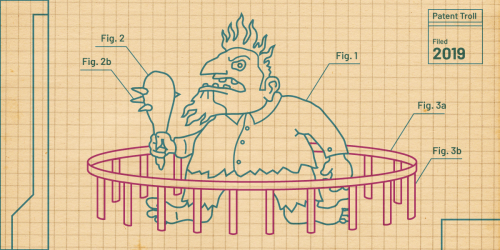 Here at EFF, we see a lot of stupid patents. There was the patent on “scan to email.” And the patent on “bilateral and multilateral decision making.” There are so many stupid patents that Mark Cuban endowed a chair at EFF dedicated to eliminating them. We wish we could catalog them all, but with tens of thousands of low-quality software patents issuing every year, we don’t have the time or resources to undertake that task.
Here at EFF, we see a lot of stupid patents. There was the patent on “scan to email.” And the patent on “bilateral and multilateral decision making.” There are so many stupid patents that Mark Cuban endowed a chair at EFF dedicated to eliminating them. We wish we could catalog them all, but with tens of thousands of low-quality software patents issuing every year, we don’t have the time or resources to undertake that task.
But in an effort to highlight the problem of stupid patents, we’re introducing a new blog series, Stupid Patent of the Month, featuring spectacularly dumb patents that have been recently issued or asserted. With this series, we hope to illustrate by example just how badly reform is needed—at the Patent Office, in court, and in Congress.
So without further ado, below is our inaugural Stupid Patent of the Month:
U.S. Patent No. 8,762,173, titled “Method and Apparatus for Indirect Medical Consultation.” This patent issued on June 24, 2014, and dates back to an application filed in November 2007. And what was the novel, nonobvious, deserving-of-patent-protection invention? Here is claim 1 in a nutshell (the full claim is at the end of this post, for those interested)1:
a. take a telephone call from patient
b. record patient info in a patient file
c. send patient information to a doctor, ask the doctor if she wants to talk to the patient
d. call the patient back and transfer the call to the doctor
e. record the call
f. add the recorded call to the patient file and send to doctor
g. do steps a. – f. with a computer.
This is a stupid patent. This is a patent on a doctor’s computer-secretary, or put another way, intermediated communications with a computer. In fact, we don’t see much difference between this patent and the patent invalidated by the Supreme Court in Alice Corp. v. CLS Bank, which claimed the abstract idea of intermediated settlement with a computer.
Given that this patent seems like it should not have been allowed because of its abstract idea, we looked at the file history (the publicly available record of what happened at the patent office). What we found was that the original claim 1 (which was similar but not identical to the claim that eventually was patented) had not claimed a computer. The examiner correctly issued a rejection, saying the claim was abstract and thus wasn’t something that could be patented. In response, the applicant added element (g) (“providing a computer, the computer performing steps “a” through “f””). And the rejection went away.
Somehow, something that wasn’t patentable became patentable just by saying “do it with a computer."
In Alice, the Supreme Court held that an abstract idea cannot be made patentable by the inclusion of a generic computer. But that’s exactly what happened in this case. As a result, this patent gets the honor of being the first entry in our series on Stupid Patents.
It is important to remember that stupid patents like these can do real harm. A patent troll with a similarly dumb patent has sent letters claiming that anyone “communicating health information to patients… by telephone” owes it money. Since defending a patent case can easily cost more than a million dollars, trolls can leverage the threat of these costs to extort settlements. By issuing vague and overbroad software patents like our inaugural Stupid Patent of the Month, the Patent Office is providing the raw material that trolls use to shake down true innovators.
- 1. Here is claim 1 in full:
1. A method of providing indirect medical consultation comprising the steps of:
(a) receiving a telephone call from a person seeking indirect medical consultation from a human health care provider;
(b) during the telephone call of step “a”, recording a set of information from the person, the set of information including
a telephone number,
a name of a patient,
an oral description of the problems with the patient, and
a selected pharmacy;
(c) before contact between the person seeking indirect medical consultation and the health care provider, transmitting this information to the human health care provider who reviews the information, and providing an option for the health care provider to be in telephone contact with the person seeking indirect medical consultation;
(d) after step “c”, based on a command from the health care provider, telephoning the person seeking indirect medical consultation and placing the health care provider in telephone contact with the person;
(e) after step “d”, recording the telephonic conversation between the health care provider and the person seeking indirect medical consultation during the telephone call in step “d”;
(f) compiling a medical record with the information of steps “b” and “e” and transmitting the compiled medical record to the health care provider which compiled medical record includes the recorded telephonic conversation of step “e”; and
(g) providing a computer, the computer performing steps “a” through “f”.







